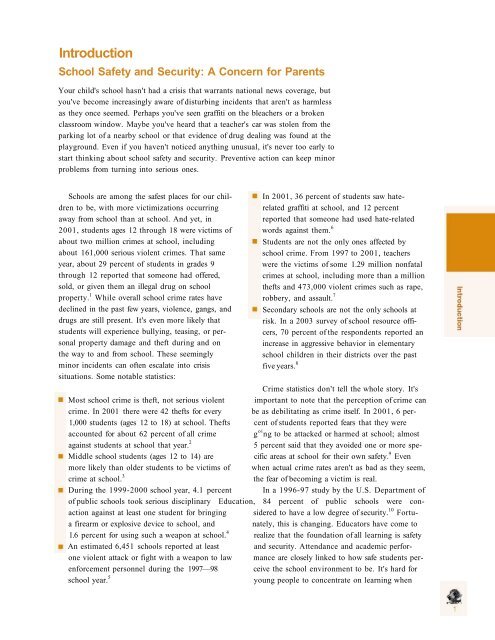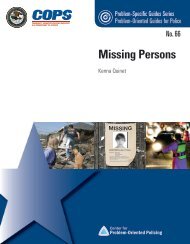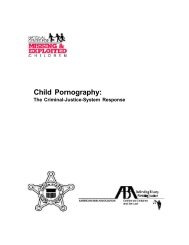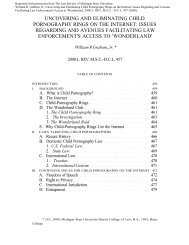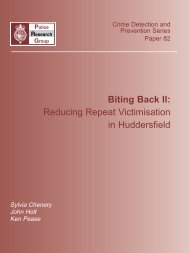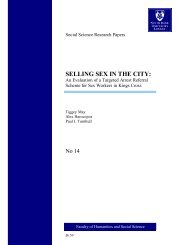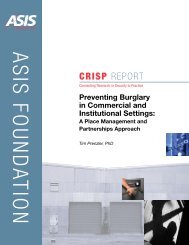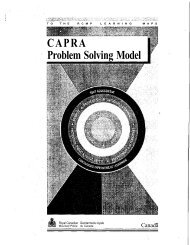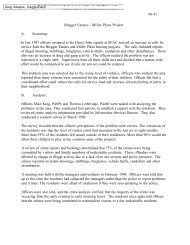National Crime Prevention Council's School Safety and Security
National Crime Prevention Council's School Safety and Security
National Crime Prevention Council's School Safety and Security
You also want an ePaper? Increase the reach of your titles
YUMPU automatically turns print PDFs into web optimized ePapers that Google loves.
Introduction<br />
<strong>School</strong> <strong>Safety</strong> <strong>and</strong> <strong>Security</strong>: A Concern for Parents<br />
Your child's school hasn't had a crisis that warrants national news coverage, but<br />
you've become increasingly aware of disturbing incidents that aren't as harmless<br />
as they once seemed. Perhaps you've seen graffiti on the bleachers or a broken<br />
classroom window. Maybe you've heard that a teacher's car was stolen from the<br />
parking lot of a nearby school or that evidence of drug dealing was found at the<br />
playground. Even if you haven't noticed anything unusual, it's never too early to<br />
start thinking about school safety <strong>and</strong> security. Preventive action can keep minor<br />
problems from turning into serious ones.<br />
<strong>School</strong>s are among the safest places for our children<br />
to be, with more victimizations occurring<br />
away from school than at school. And yet, in<br />
2001, students ages 12 through 18 were victims of<br />
about two million crimes at school, including<br />
about 161,000 serious violent crimes. That same<br />
year, about 29 percent of students in grades 9<br />
through 12 reported that someone had offered,<br />
sold, or given them an illegal drug on school<br />
property. 1 While overall school crime rates have<br />
declined in the past few years, violence, gangs, <strong>and</strong><br />
drugs are still present. It's even more likely that<br />
students will experience bullying, teasing, or personal<br />
property damage <strong>and</strong> theft during <strong>and</strong> on<br />
the way to <strong>and</strong> from school. These seemingly<br />
minor incidents can often escalate into crisis<br />
situations. Some notable statistics:<br />
In 2001, 36 percent of students saw haterelated<br />
graffiti at school, <strong>and</strong> 12 percent<br />
reported that someone had used hate-related<br />
words against them. 6<br />
Students are not the only ones affected by<br />
school crime. From 1997 to 2001, teachers<br />
were the victims of some 1.29 million nonfatal<br />
crimes at school, including more than a million<br />
thefts <strong>and</strong> 473,000 violent crimes such as rape,<br />
robbery, <strong>and</strong> assault. 7<br />
Secondary schools are not the only schools at<br />
risk. In a 2003 survey of school resource officers,<br />
70 percent of the respondents reported an<br />
increase in aggressive behavior in elementary<br />
school children in their districts over the past<br />
five years. 8<br />
<strong>Crime</strong> statistics don't tell the whole story. It's<br />
Most school crime is theft, not serious violent important to note that the perception of crime can<br />
crime. In 2001 there were 42 thefts for every be as debilitating as crime itself. In 2001, 6 per-<br />
1,000 students (ages 12 to 18) at school. Thefts cent of students reported fears that they were<br />
accounted for about 62 percent of all crime g oi ng to be attacked or harmed at school; almost<br />
against students at school that year. 2<br />
5 percent said that they avoided one or more spe-<br />
Middle school students (ages 12 to 14) are<br />
cific areas at school for their own safety. 9 Even<br />
more likely than older students to be victims of when actual crime rates aren't as bad as they seem,<br />
crime at school. 3<br />
the fear of becoming a victim is real.<br />
During the 1999-2000 school year, 4.1 percent In a 1996-97 study by the U.S. Department of<br />
of public schools took serious disciplinary Education, 84 percent of public schools were conaction<br />
against at least one student for bringing sidered to have a low degree of security. 10 Fortua<br />
firearm or explosive device to school, <strong>and</strong> nately, this is changing. Educators have come to<br />
1.6 percent for using such a weapon at school. 4 realize that the foundation of all learning is safety<br />
An estimated 6,451 schools reported at least <strong>and</strong> security. Attendance <strong>and</strong> academic perforone<br />
violent attack or fight with a weapon to law mance are closely linked to how safe students perenforcement<br />
personnel during the 1997—98 ceive the school environment to be. It's hard for<br />
school year. 5<br />
young people to concentrate on learning when


